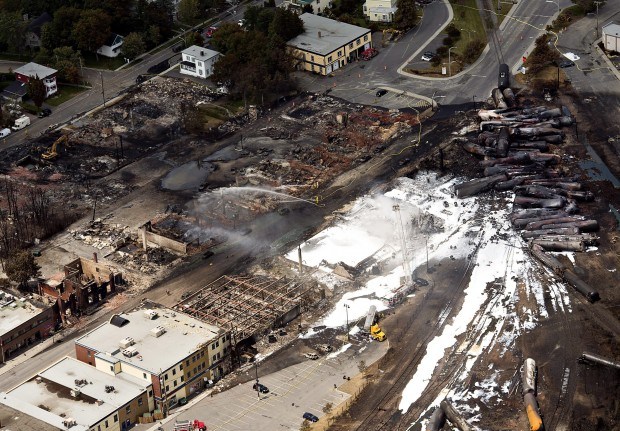Canada’s biggest railway struggled to keep some heavily used track in adequate repair even after a string of derailments last year showed the danger of moving oil on poorly maintained track, documents obtained by Reuters show.
Three trains derailed along one 296 mile (476 km) section of Canadian National Railway Co track in northern Ontario in February and March last year. The third train spilled crude oil in and around a river near the town of Gogama, igniting a fire that burned for days.
More than 100 pages of correspondence and inspection reports obtained by Reuters under Canada’s freedom of information law show that a March inspection by Transport Canada, the ministry responsible for rail safety, found a number of problems with the track.
But the documents also show that during a July inspection, months after normal operations resumed, inspectors found new track problems, including rail that had been secured with too few bolts, and defective ties. CN brought its trains back up to normal speeds in late May. (Graphic: http://tmsnrt.rs/1reqKif)
CN Rail told Reuters the July inspection ultimately uncovered 57 defects, including 10 that required temporary speed reductions. Seven of those 10 were on the main line. CN said the defects found in July were repaired by Sept. 3.
Transport Canada lifted its March safety notice on Dec. 15, 2015, signaling that it believed safety problems in the area had been resolved. But the regulator has not conducted a track inspection since July. Evidence that problems persisted after the first inspection has one residents’ group wondering how definitive the ministry’s all-clear is.
“Wow. It wasn’t taken care of,” said Natalie Sear-Beland, spokeswoman for the Gogama Citizens’ Committee, a group formed last year, after learning about the July inspection results.
Sear-Beland said the town has been “completely in the dark” about track conditions, and she fears there could be another accident.
“We have heard nothing from Transport Canada,” she said. “If Transport Canada were more hands on, more often, I think they wouldn’t have as many problems.”
CN says it took “decisive action” after the derailments, adopting new procedures, audits and checklists to prevent maintenance errors, increasing inspections, raising some internal track repair standards, and increasing engineering supervision in the region.
“We believe the citizens of Gogama should be reassured by Transport Canada’s satisfaction with the current condition of the Ruel Subdivision,” the railway said in a statement.
The railway’s overall accident rate improved in 2015, coming in below the industry average, CN said.
“CN is investing heavily in people, process, capital and technology to minimize risk and continually reduce accidents and injuries,” said Sam Berrada, vice-president for safety and sustainability, in an e-mailed statement.
Rails and Human Factors
Transport Canada, made aware of the Gogama resident group’s concerns said: “Canada maintains one of the safest rail transportation systems in the world as a result of shared efforts between numerous partners including governments, railway companies and communities.”
Investigations into last year’s cluster of derailments are still ongoing, but CN said it believed they were “likely caused by a combination of track conditions, inadequate process controls and human factors.”
The documents show Transport Canada sent CN a safety notice on March 12, 2015, days after the Gogama derailment, saying that defective rail conditions may have played a role. “As such, there is risk that another derailment may occur before the root cause is found,” it warned.
Inspectors monitored CN’s track repairs and the railway’s work to determine causes in the months after the derailments.
Last year, a Reuters analysis found that CN’s safety record had deteriorated in 2014, as accidents in Canada linked to poor track conditions spiked. There was no similar pattern at the competing Canadian Pacific Railway Ltd. CN blamed the trend on bad weather and heavy traffic, and later promised to spend C$500 million upgrading track in Western Canada. (http://reut.rs/1rnzkv5)
The railway has not suffered a severe derailment since the Gogama accident, but the inspection reports describe defects that could have increased the risk of accidents along a line that carries oil trains from Western Canada to refineries on the east coast.
Ian Naish, a former director of rail and pipeline investigations at the Transportation Safety Board, reviewed the inspection reports, and said they showed CN did not meet minimum track safety standards designed to prevent derailments.
“There are lots of places where they weren’t in compliance,” he said. On the seven defects serious enough to require speed restrictions on the main line, Naish said: “It seems to me there shouldn’t be any, if they are doing regular inspections.”
Of the 10 defects that required speed restrictions, CN said eight involved track geometry, and two involved ties.
Frances Gelinas, the member of provincial parliament who represents the area, said Gogama, which depends on tourism revenue, is still feeling the effects of the derailment.
“It is life before the derailment, and life after the derailment. Nothing is the same,” she said. “Recruiting tourists to come and hunt and fish in Gogama is really tough.”
Some local residents have retained a civil litigator, James Wallbridge, but Wallbridge said they have not yet decided how to proceed.
“We are going to review the cleanup efforts and we should be in a position to make some decisions by the end of May,” he said.
CN declined to comment on how the cause of the derailments might affect its liability, or whether any damages could be material.





















 Ford Recall of 43,000 SUVs Due to Fire Risk Won’t Remedy Gas Leaks
Ford Recall of 43,000 SUVs Due to Fire Risk Won’t Remedy Gas Leaks  Viewpoint: Risks for D&O Insurers Exploring the New Frontier of Gen AI
Viewpoint: Risks for D&O Insurers Exploring the New Frontier of Gen AI  Florida Gets 8 New P/C Carriers After Insurance Market Reforms
Florida Gets 8 New P/C Carriers After Insurance Market Reforms  Travelers: Distracted Driving Incidents Continue to Rise
Travelers: Distracted Driving Incidents Continue to Rise 







